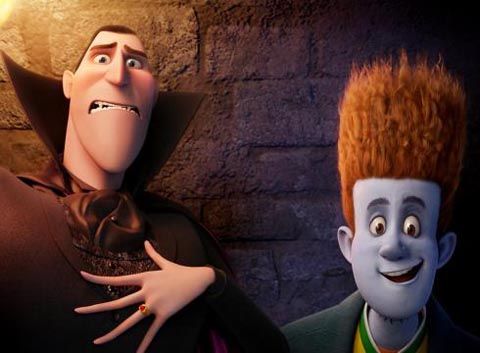

EXCLUSIVE: Interview With The Artists Who Demand Better Working Conditions At Sony Pictures Imageworks

Labor violations in the visual effects industry are nothing new; they have simply become more public thanks to a vocal online community and watchdog sites like VFX Soldier. The growing awareness is also part of the maturing of the vfx industry, which is still a relatively young art form compared to feature animation. In the past decade, most of the highest-grossing films at the global box office have been visual effects-driven, yet there has been no trickle-down benefit to the artists who have helped these media conglomerates make hundreds of millions of dollars.
A group of artists at Sony Pictures Imageworks is leading a push for change at their studio that could have big ramifications for the rest of the vfx industry in Los Angeles. Their goal is to unionize Imageworks, and they are promoting their cause publicly through the SpiUnion blog, as well as Twitter and Facebook accounts.
What makes the plight of Sony’s artists particularly urgent is that there are different standards of treatment for LA-based artists working on the same films: Sony Pictures Animation artists enjoy union benefits, whereas Sony Pictures Imageworks artists don’t. In other words, if you’re storyboarding and designing films like Cloudy With a Chance of Meatballs and Hotel Transylvania, you get treated better than if you animate on those same films in Los Angeles. This divide-and-conquer tactic that Sony uses is distinct from other Los Angeles feature animation studios like DreamWorks and Disney Feature Animation that extend union benefits to all their artists, including the animators.
To learn more about the situation, Cartoon Brew conducted an interview with the Imageworks artists who are leading the effort to unionize the studio. For obvious reasons (i.e. not being fired), they have chosen to remain anonymous.
CARTOON BREW: As an outsider, I struggle to understand the mindset of the vfx industry and why it’s so difficult to organize those within it. Can you shed some light into why the vfx field has been so reluctant to organize in LA, especially considering the working conditions, which involve ridiculously long hours. It seems that union representation like your counterparts in CG feature animation would be a benefit.
Artists of SpiUnion: Yes, you would think so right? It’s just as difficult for us to understand as well. We can’t speak to the economics of other companies, but we feel Sony is in a unique situation as opposed to other purely vfx facilties. We produce our own content (Cloudy With a Chance of Meatballs, Smurfs), we produce the 3D content our parent company depends on to sell 3D Blu-ray players and televisions, we’re partially unionized (SPA) already, we produce vfx for other studios, we have offices in multiple countries, and we’re owned by one of the major studios.
The LA vfx industry seems to based on FUD (Fear , Uncertainty, and Doubt). There is the prevailing opinion that if any artist dares to stand up and make any noise, the entire company/industry will closeup shop and leave town. Companies are not in LA out of the kindness of their hearts, they are here because there is a large talent base here. (See VFX Soldier’s post on the Animation Guild’s membership and agglomeration.)
People need to ask why are the directors, producers, actors, cameramen, grips, best boys, are all union, but not us? We certainly don’t dare stand up and say anything for fear of angering the mothership right? In the last year we have made multiple projects that either our parent company is making (Men in Black 3, The Amazing Spider-man) or projects where we are outright the content owners of (Hotel Transylvania, Smurfs 2). How are we not a feature animation company these days?
CARTOON BREW: Sony Pictures Imageworks (SPI) isn’t union while Sony Pictures Animation (SPA) is. There may be some people confused as to the distinctions between these two arms of Sony so can you explain what films you work on versus what the unionized SPA works on.
The 38 union employees of SPA do all the “pre-production” work for Sony animated features. Storyboards, concept art, character design, etc. Once the movie is ready to start going into the actual shot production process, the “client” (SPA) will then give the project to the “vendor” (SPI) who will then make the finished project. It’s similar to our relationship with the late ImageMovers. It’s an odd distinction, since we are right next to each other, and in some cases work in the same building. So we work on the same films. Five percent of the residual revenue from the movies we make goes to the unionized part of the company to pay their pension benefits. The rest of us get nothing. This is seen as not only fair, but essential to the business of the company. This is not an attack on SPA in any way; they were the smart ones, and voted to unionize when they had the chance.
CARTOON BREW: By going union, what benefits do artists at Sony Pictures Imageworks stand to gain which aren’t currently provided by the company itself?
The biggest gains are portable benefits that travel with you. Many artists will work a short term (five months or less) on a show, and then be unemployed. Many longer term artists will also be let go with no warning at all by the whim of company management.
(Our apologies to your foreign readers, but some of the following is very US specific.) If the project you are on ends on a Friday, if you want health insurance, you need to pay the $1000+ for COBRA benefits in the following 30 days, and then every month thereafter. Dropping COBRA is not advised, since then you will have to try to find individual coverage as opposed to being under the group COBRA coverage. This excludes anyone with a pre-existing health condition. Under the TAG plan, when you lose your job, you now have six months of health insurance (and up to 18 months depending on your hours worked in the previous year) for yourself, your partner, and your dependents. You can go work on a non-union commercial for 4 weeks, while you wait for Sony to call you back.
There are also several retirement and pension plans offered. This is in addition to guaranteed paid overtime (the amounts of “free”, “voluntary”, and off-the-books OT worked is unbelievable), vacation days, sick days, guaranteed wage minimums, and a voice in the contract that we all work under. Many staff hires receive zero benefits beyond an HMO that ends as soon as you are layed off. No retirement plan, no sick days, no vacation days.
It’s absolutely puzzling why an artist wouldn’t want these benefits, and will vocally campaign that they don’t want them. The public sees movies for the hard work the vfx artists put into the films, but we receive less benefits than nearly everyone else on the film. This is seen as not only equitable but essential to the business of the film industry. At what point do people wake up? Our work provides billions of dollars in profit to Hollywood.
How sad a statement is it about ourselves that portable health insurance and a retirement pension is seen as some kind of major extravagance that we don’t deserve?
CARTOON BREW: SPI tried to organize a union drive in 2003 and the employees at the time voted overwhelmingly against that proposal. What has changed at SPI in the past ten years, and why do you feel the employees today will be more receptive to the union proposal.
Staff employees at the time received a nice benefits package, it had profit sharing amongst other things. No one seemed to want to admit that those benefits could all be taken away at a moments notice, and they all eventually were. A matching 401k, and poor health insurance are about the only major benefits they have left, and this could be removed at any time as well. Since that time there has been a steady erosion of benefits for all employees.
Imageworks employees have lost 10 years of pension and benefit contributions that they could have been earning. We should all ask ourselves: Have we seen our workplace conditions improve or degrade in the last ten years? How many of those conditions did we have any say in at all?
People that were here for 15 years were summarily dismissed, everyone feels like their jobs could be gone at any moment, and many are afraid to “rock the boat” and feel lucky “to just have a job at all”. The makeup of the company is now mostly people that are hired for one show, and then immediately let go when its over. This is exactly the group of people that needs portable benefits most. We have many ex-Disney, Dreamworks, and ImageMovers artists working here still enjoying their medical benefits they earned while working at those union companies.
Ten years ago we didn’t have a central resource for information and people felt TAG was not involved enough at the time. We have a resource now at spiunion.wordpress.com. Steve Kaplan, the Animation Guild organizer, has been great helping us answer people’s questions. Follow us on Twitter and Facebook, where we post people’s questions anonymously if they don’t want to be identified.
CARTOON BREW: My understanding is that in the past, Imageworks’ treatment of permanent staff was much more generous than production hires who received little health/retirement benefits. Is this still the case? Also, approximately how many of SPI staff are “permanent” and how many are short-term production hires?
Yes, it is still the case that “staff” artists receive more benefits than production artists. But, to the best of our knowledge, no one is “staff” anymore, just who is more or less likely to be laid off the instant your last shot is done on a show. The failed union vote of ten years ago actually caused show/production hires to get more benefits. There has been a serious erosion in benefits from the meager benefits the company once provided to people. Many show hires receive zero benefits beyond an HMO that ends as soon as you are laid off. No retirement plan, no sick days, no vacation days. This is occurring as the company rakes in Smurf money that we helped make.
The exact employee numbers are always in a state of flux. According to the Animation Guild, there are 38 SPA employees. There are somewhere between 400-500 Imageworks artists in LA, and another 100+ in Vancouver, soon to be 250+. There are 30-40 artists in Albuquerque, with an unknown number of those to be relocated between LA and Vancouver.
CARTOON BREW: Besides its LA studio, SPI also has facilities in New Mexico and Vancouver. It was recently announced that the New Mexico studio would close (after less than five years of operation) and the Vancouver studio would expand. What is there that prevents Sony from moving its entire operation to Vancouver? Do you fear that unionization in LA would make Sony push more of its production up north?
This is the argument that is most repeated and makes no sense to us. If the company were capable of moving all the work to Vancouver (or anywhere else in the world), they absolutely 100% would. The agglomeration of people in LA is the why the company is still here. If you look at it from a different point of view, if the company gets a 30% rebate on its work, why in the world would they have ANY artists at all in another location? The answer is that there are key people and departments who won’t move. This is leverage in action. By all accounts, Albuquerque was a profitable division.
Someplace else offered more incentives, so the company is chasing the free government handouts. Don’t be surprised in the future to see Vancouver divisions shutting down and opening up in other locations as every company chases incentives to the next hot location. Our opinion has always been that as an individual artist you have no control over what another country decides to do economically. You have no control over any other business decision that happens way over your head. What you can control is that you will accrue pension and health benefits while you are working. These will continue after you are unemployed for yourself and your family.
We are not trailblazing a new idea and fighting to set up a new organization. TAG has existed for every seventy years, and has served the employees of Disney, Dreamworks, Nickelodeon, SPA and many others. Why would anyone not want to have the same benefits? All anyone at any studio in the US or Canada need to do is sign and mail a rep card to get the process started.

.png)